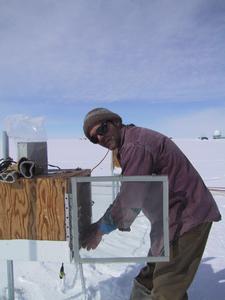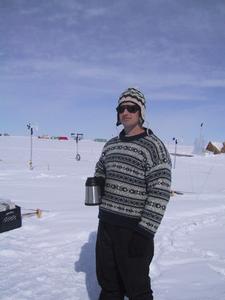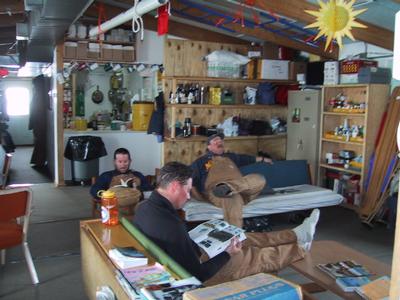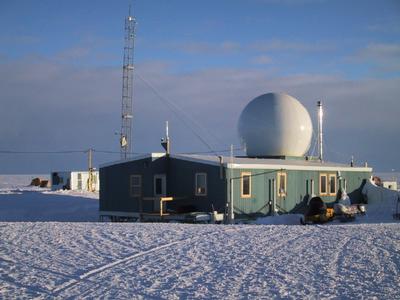
|
24 July, 2001An overview of what's happening at Summit camp this summer It's hard to believe what a busy place this is when you think how few people are here. I am one of just 21 people here. 14 are VECO support people, 6 scientists and me - “the teacher”. Presently, there are 4 science groups running independent but interrelated projects. There are approximately 10 other science projects going on that are being supervised by two VECO support science technicians, Meg and Shelly. As you can see Meg and Shelly are very busy everyday, checking instruments, recording data and trouble shooting for the absentee scientists. It is incredible that it all keeps going. Here is a complete list of the science projects taking place at Summit this summer. The *’d projects presently have scientists here at the camp. Many of the other scientists will be joining us in another week, for the closeout of the summer science season and the preparation for the “winter over”. *University of New Hampshire: Jack Dibb and Ted Shultz Accumulation stake array, analysis of major ions in snow, atmospheric photochemistry, and summer experiments (photochemistry experiments in collaboration with R. Honrath, Michigan Tech). PI for proposed 3-year continuation of photochemistry experiments. snow accumulation *Swiss Federal Institute of Technology. Atsumu Ohmura, Sebastian Hab, Saskia Bourgeois and Peter Schelander Year-round measurement of incoming and outgoing radiation, turbulence and energy balance. (collaborative with K. Steffen, U. Colorado) feature story on Sebastian *University of Arizona: Roger Bales, Manuel Hutterli, Hans-Werner Jacobi, Dee Belle-Oudry and Markus Frey. Air-snow exchange of H2O2, HCHO and related species. On-site year-around measurements of snow and atmosphere, and summer experiments. list of experiments *University of California, Irvine: Donald Blake, Nicola Blake. Aaron Swanson. Year-round canister samples for hydrocarbon, halocarbon and alkyl nitrate; and summer experiments, snow and atmospheric photochemistry (collaborative with R. Honrath, Michigan Tech). Cold Regions Research and Engineering Laboratory, U.S. Army Corps of Engineers. Mary Albert. Characterization of snow & firn physical characteristics on year-round samples and during summer experiments. feature story University of Washington: Eric Steig. Year-round samples of water vapor for analysis of stable isotopes. feature story National Survey and Cadastre, Denmark. Trine Dahl-Jensen and Soren Gregersen. Continuous seismic monitoring at GEO Summit. feature story Carnegie-Mellon University: Cliff Davidson. Analysis of major ions collected year-round on aerosol filters. Desert Research Institute. Joseph McConnell Analysis of year-round surface snow for development of high-resolution trace element records. Laboratoire de Glaciologie et Géophysique de l'Environnement. Jean Luc Jafrezzo. Year-round sampling of atmospheric aerosols and gaseous species. National Institute of Standards and Technology: George Klouda Year-round high-volume aerosol filters for carbonaceous aerosols. National Oceanic and Atmospheric Administration, Climate Monitoring and Diagnostics Laboratory. Sam Oltmans, Ozone and Water Vapor Group; and Pieter Tans and Tom Conway, Carbon Cycle Group. Year round measurements on atmospheric ozone; and year-round analysis of flask samples of air for carbon-cycle compounds. Michigan Technological University. Richard Honrath, Sarah Green and Matt Peterson. Summer experiments, snow and atmospheric photochemistry. Purdue University. Paul Shepson and Ann-Louise Sumner. Summer experiments, snow and atmospheric photochemistry (collaborative with R. Honrath, Michigan Tech.). University of Colorado. Konrad Steffen and Detlev Helmig. Year-around meteorological and energy-balance measurements (collaboration with A. Ohumra, Swiss Federal Institute of Technology); summertime vertical profiling of ozone within the planetary boundary layer. University of Michigan. Robert Clauer and Vladimir Papitasvili. Continuous magnetic measurements in the vicinity of GEO Summit. University of Wisconsin, Milwaukee. Jonathan Kahl. Year-round modeling of back trajectories for Summit. In addition to these science activities, there are construction projects and just keeping the heat, lights water and food all going. Everyone here works long days in harsh conditions. It is an amazing scene. If you’d like a virtual tour check out the web site Greenland Summit camp and click on “virtual tour”. For more information on these science projects and the camp read GEO summit
Contact the TEA in the field at . If you cannot connect through your browser, copy the TEA's e-mail address in the "To:" line of your favorite e-mail package. |









